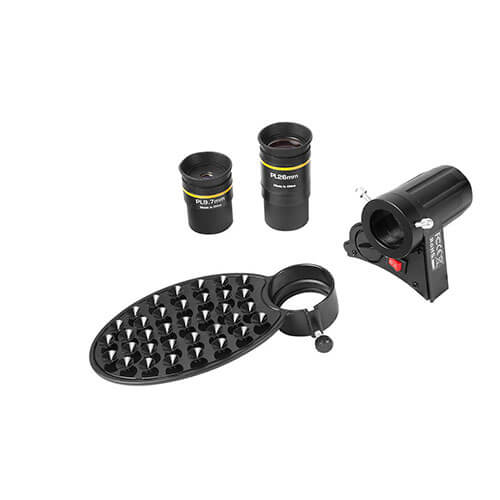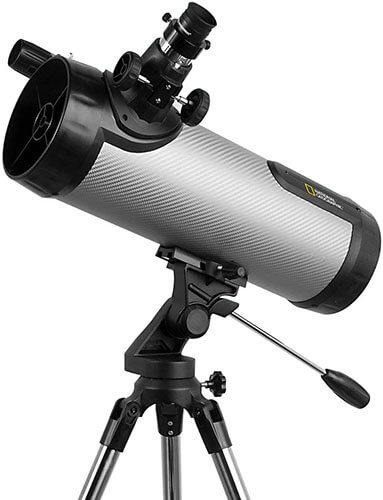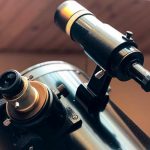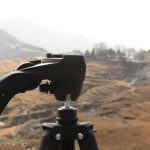National Geographic Telescope NT114CF Review
This National Geographic Telescope NT114CF review will discuss various aspects, features, and functions of the telescope. The National Geographic NT114CF Telescope is a Newtonian reflector telescope with a 4.5-inch (114mm) aperture.
If you are a beginner to the world of telescopes and aren’t sure what a Newtonian reflector telescope is, here’s a brief explanation. Named after its inventor Sir Isaac Newton the Newtonian reflector telescope forms an image by reflecting light from mirrors.
His main reason for creating the reflector telescope was to avoid the chromatic aberrations (a lens cannot focus all colors on a single point) occurring in refractor telescopes.
Should you be reading this review because you’re on the lookout for a starter telescope for your child, then you can’t go far wrong with the National Geographic NT114CF.
It’s low price, and the carbon fiber body makes it lightweight and easy for kids to deal with—basically an ideal choice for kids and beginners looking for their first telescope.
National Geographic Telescope NT114CF Specifications
- 4.5-inch (114mm) aperture. This size aperture will gather enough light to view the moon, planets, and various other deep space objects.
- f/5.2 focal ratio (speed of a telescope’s optics), the smaller the f-number, the wider the viewing field but with lower magnification.
- With the telescope are two interchangeable Plossl eyepieces and a 2x Barlow lens.
- An altazimuth mount.
- Carbon-fiber optical tube.
- There is a tripod with an accessory tray.
- An adapter for using a smartphone that allows image capture of what you’re viewing
- Stellarium software, a red dot viewfinder, and a downloadable star map help with star navigation.

The NT114CF Carbon-Fiber Optical Tube Assembly Advantages
The NT114CF has an advantage, and that’s the carbon-fiber tube. The reason is the weight reduction. If the scope is lightweight, it doesn’t require a heavy, sturdy tripod for mounting the tube.
Looking through bigger and heavier tubes plus their correspondingly heavier tripods can increase vibrations while you’re viewing. A much lighter tube and setup reduce the amount and severity of vibrations.
A lower price telescope having a carbon-fiber tube rather than an aluminum tube should be seen as an advantage. Here’s the reason: before you engage in stargazing, you need to ensure your telescope corresponds to the temperature where you’re using the scope.
If you don’t allow the tube to cool sufficiently, you will see image distortions and focusing problems because of heat rising inside the tube.
Aluminum takes more time to cool down and doesn’t react as well to temperature fluctuations as carbon-fiber.
Setting Up The NT114CF Telescope
Another excellent reason for beginners to purchase this telescope is that it arrives almost totally assembled, making it dead easy for you to get a start on your viewing quickly.
But we said almost assembled, so there are a few things that still require setting up. The first job after receiving the package and emptying the box is setting up the tripod.
Pull open the tripod legs until the spreader bars lock. The spreader bars on a tripod prevent the legs from splaying out too far and allowing the whole setup to sink to the ground. They also help with stability. Remove the accessory tray from the box and fix it to the spread bar.
Later, the accessory tray will be an excellent place to pop your eyepieces and Barlow lens when you’re viewing.
Remove the metal mount head from the packaging. You’ll find a bolt on the bottom of the mount, take it out so you can place the mount onto the tripod. Replace the bolt and tighten it, so it’s secure.
A handle controls the mount’s movements and serves as a lock for the altitude swivel; this requires threading into the mount. The azimuth locking knob is also on the mount head.
After you secure the mount and tripod correctly, you need to position the tube onto the mount. Fit the telescope’s tube on the mount and ensure it’s in a secure position before you tighten the side knob. Now attach the red dot finder on the telescope.

NT114CF Collimation
Newtonian reflectors require collimation, and this is one reason why beginners shy away from these telescopes. Collimation is simply the aligning of the primary and secondary mirrors to obtain perfect imaging.
In modern telescopes, the collimation is done at the factory. Sometimes during transit, the collimation can be affected, and then the telescope will need collimating. Even then, there are numerous articles online showing how you can accomplish this.
The National Geographic NT114CF Telescope’s Magnification
Take the eyepieces’ focal and the length of the telescope’s tube to determine the magnification of the National Geographic NT114CF telescope. This particular telescope lists it at 19x and 51x magnification using the eyepieces, which are part of the package when you purchase the NT114CF telescope. You can calculate yourself by taking the telescope 500mm’ length and dividing it by the eyepieces’ focal length 26mm and 9.7mm.
If you use the Barlow lens, that will double the eyepiece magnification for you. To use a Barlow lens, it has to be positioned first into the eyepiece holder. Then slot the Barlow lens inside the eyepiece.
Remember, the Barlow lenses only double the eyepiece’s magnification; it doesn’t make it possible to see objects more precisely than the eyepiece’s quality allows. It’s always better to upgrade your eyepieces before buying more powerful and expensive Barlow lenses.
High power magnification is best for the moon and if you’re looking at planets. For deep-sky objects, you need to use lower-powered eyepieces; they will give you a wider field of view.
What Will You See Through The NT114CF?
Many people who take up astronomy hope to see those fantastic deep sky images we all see on TV. These incredible images do not come from a low-cost beginner telescope such as the NT114CF. However, you will see bright objects such as the Andromeda galaxy, the Pleiades, and the Orion nebula.
It’s also possible to view Saturn with the rings, Jupiter, and some moons, but the other planest will only be distant dots.
The moon will be your best bet. You can see the moon’s craters and the terrain, and it is where you’ll see the most benefit from purchasing the NT114CF.
Is The National Geographic NT114CF Telescope A Good Purchase?
During this National Geographic NT114CF review, we have spoken about this telescope’s quality, accessories, how to set up the telescope, and what is possible to view with the scope. But is it an excellent telescope to purchase for children and beginners?
From a price point of view, and considering the NT114CF is a Newtonian reflector with a 114mm aperture, which is a nice size, it’s an ideal first telescope, undoubtedly. The ease with which anyone can set it up, the lightweight carbon-fiber tube, and the accessories that come with it all make this a very entertaining and useful tool for children and beginners.




















